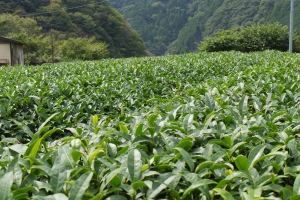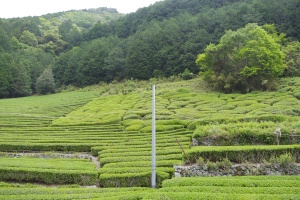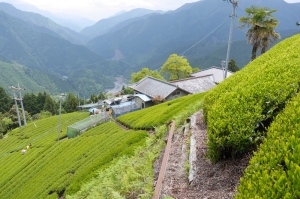I have a lot of trouble adding content to the blog, firstly for reasons of time, but also for fear of redundancy of information, and because I would like to avoid doing simple reviews of the teas that I select. Nevertheless, it is time for a comprehensive review after the 2023 spring harvest season.
We can say that this season has been difficult. The weather conditions will have been responsible for the unregular growth of the leaves of the tea plants. The overall result is a season with low quantities. The harvests were also very early, new records were broken almost everywhere, in the plains as in the mountains. If we can say that the early zones tended to produce quality, the later zones suffered from more uneven harvests, sometimes due to localized episodes of frost, which also did not improve the question of quantities.
Early harvests do not necessarily always mean rapid arrival of teas in stores. Particularly in the case of producers refining aracha (non-refined) tea themselves, they often cannot process this task before the very end of the spring harvest. More rarely, they are taken immediately by the second harvests before finally being able to do the refining, this is why black teas can take time to arrive on sale, their refining being treated later than that of sencha.
This question of refining is obviously crucial. It is in principle the prerogative of wholesalers. If some also make their know-how available to producers (some choose to ask this work to wholesalers) or to retailers, who like me, source certain teas directly as non-refined aracha, it is obvious that they will treat their own teas as a priority. This is why I had to wait until the beginning of August to have refined the Murakami sencha that I buy in aracha.
However, for me, sourcing tea in aracha is very interesting, it allows me to have completely original teas. This is the case for my teas from Asamiya, Tosa, Umegashima and others. But the limit to this method is obviously the question of refining, I have to find someone to do it for each of these teas, failing to have the necessary infrastructure. This is why retailers that operate in this way remain very rare.
I remind you that the refining of tea consists roughly of sorting the stems, the powder, the leaves that are too large, etc., a possible calibration (cut) of the leaves, and finally, an essential phase, a final roasting (of 5% of the humidity remaining in the aracha goes to around 3%) which depending on the method can radically change the character of a tea. A weak roasting will give a tea that is still very greenish, vegetal, while a strong roasting will give a sweeter, fruity, empyreumatic tea.
For my part, I can also sometimes have a refined tea order-made by a producer, as has been the case with Yamakai from Yabe for several years, as well as this year with the Yabukita from Yabe, which I request without shading. Or the Sayama-Kaori from Sayama, which I requested as asamushi, made on a small 35 kg production line (with a 35 kg line, we obtain around 5-6 kg of aracha tea, * See Note 1). There is a certain risk taking. It is difficult to refuse a tea that you have ordered like this, even if it is not what you had dreamed of.
This allows me to move on to Yabe teas. Within Yame, Yabe is a village where the plantations are located at an altitude of 500-600 m, which is rather high in the Japanese context. The sencha there are of good quality, and it is a shame to see that everything is shaded as is the norm in Yame, and even in Kyûshû more generally. Although I have been ordering an unshaded Yamakai for several years (shading causes this cultivar to lose all its aromas), this year I took the plunge and also ordered a Yabukita. After all, when you really love sencha you can only admire the richness of Yabukita, as a standard present everywhere, it is the best tea to get an idea of the work of a producer. With its intense milky aromas with notes of raspberry, Yamakai is wonderful again this year. The Yabukita didn’t disappoint me either. Robust but not aggressive, it may seem simple at first, but the richness that develops over time is exceptional. It is one of those teas, not so common, which seem even more delectable to me on the second infusion.
Same combination from Asamiya, Yamakai, then this year, sourcing from the same producer of a Yabukita as well.

Not very famous to the general public, sought after by connoisseurs, Asamiya is located in the commune of Shigaraki, in the Shiga prefecture. Not far from there, on the other side of the mountains to the southwest, that is to say on the other side of the border with the Kyoto prefecture, is Wazuka, the first producing region of Uji tea (* Cf. Note 2), which undoubtedly casts a lot of shadow over Asamiya. Despite the proximity, the relief and geography make this area cooler, with later harvests. In Asamiya, unlike Uji, we mainly make real sencha without any shading.

With this Yamakai, we have reached new heights, it is a marvel, very sweet and very fragrant with its famous raspberry aromas, it is in my opinion the most typically Yamakai of all those that I offer, it also draws from the best. So, I could only expect a lot from Yabukita, and he gave me even more. I recommend it to both complete beginners and seasoned connoisseurs. If you don’t like this sencha, it’s just that you don’t like sencha.
The Kôshun, from another producer, is once again a delight this year.
We go back again to the north-east of Japan, to evoke the teas of Umegashima. Like Tamakawa or Tochisawa for example, Umegashima is one of the tea production areas of Hon.yama. Hon.yama being roughly the large mountain area north of the city of Shizuoka, in which the Abe-gawa River and the Warashina-gawa River flow. Umegashima is the most upstream tea growing area of the Abe River. Unfortunately, the desertion of tea production there, as elsewhere in these mountain areas, is particularly worrying.
Within Umegashima itself there are of course smaller localities. Several years ago, I started sourcing aracha teas from Umegashima after being introduced to the producer of an old plantation of zairai tea plants (old indigenous tea plants grown from seeds, all different therefore, unlike the cultivars obtained by cuttings) in Nyûjima. From there I was able to extend my scope to other plantations, but whose leaves are processed in the small factory in Nyûjima, on an old 35 kg line. The teas there are perhaps less sexy than those from Asamiya, but nevertheless they are very rich, robust, deep, with the particular aromas of this region.
New this year is Shinden’s Kurasawa cultivar. There are very few, barely enough to make a batch on the 35K line. Parent of Kôshun, Kurasawa (Shizu-7111) is very rare. It has a scent that is difficult to define but very particular. This one is exceptionally robust.

A change this year, I decided to do a stronger final firing on the zairai from Nyûjima to have sweeter aromas, while keeping the typical body of these indigenous tea plants which can lack clear characteristics, thus making a weak roasting less justified than on a cultivar. I hope you like this change this year.

The Yabukita of Nyûjima is also present this year, however I skipped the Yabukita of Fujishiro to turn to that of Tomochi, at an altitude of 800 m, which thus comes to accompany the Sayama-kaori of the same locality. This Yabukita seems to me this year to be very representative of the aromas of Umegashima, and the Sayama-kaori clearly shows the typicality of this far too underestimated cultivar.

I had Sayama make a Sayama-kaori in futsumushi, carefully on a 35K line. Obviously, the quantities were small, having only ordered a “batch”, and this tea is already sold out. And for good reason, what sublime and astonishing perfumes. I had never seen such an aromatic Sayama-kaori. My only worry, will the same quality be reproduced next year?
Another nice surprise, the tamaryokucha from Ureshino cultivar Benifûki. For several years, I have been offering kama-iri cha benifûki from this Ureshino producer, but this is the first time that I have been able to have it in steamed tamaryokucha. No shading, and standard steaming of course. It’s precisely that he makes tamaryokucha without shading and not fukamushi that I like about this producer. Without excessive astringency, benifûki is dry and light, refined with its aromas evoking grapefruit, surprising on a benifûki. Quite different from the other tamaryokucha from this producer, this is a surprising and pleasant tea.
Quickly I would like to introduce a new young potter in the “collection”, Nakagawa Takanori. Born in 1981, he is active in Tokoname, and works under the direction of Konishi Yôhei. Like the latter, these teapots are cooked over a wood fire in an anagama oven. Unlike another student of Konishi Yôhei, Shiraiwa Taisuke, Nakagawa Takanori is not really very productive, but his teapots are of very high quality, for really (too) low prices.
To finish, I would like to address a completely different point, not related to my activity, but which seems important to me to point out. Since October 2022, Japan has reopened to mass tourism. The influx of foreign tourists is of course a boon for Japan’s economy. At spring in particular we saw a phenomenal number of Western tourists storming the tea producing regions as well as teapots producing areas incidentally. I am convinced that things go wonderfully most of the time, but I have had a lot of feedback, if not always completely negative, at least embarrassed from producers seeing tourists arriving without any appointment or notice. Some may have adequate structures in place (those with their own shop for example) with staff to welcome visitors, but most of the time, this is not the case. One need to understand that spring is a crucial season for them, on which depends their income for the coming year (the following harvests bring in virtually nothing). Actually, in certain areas the plantations themselves are not 100% safe (there are ticks, snakes, oversized hornets, etc.), the factories can also carry risks. And any problem or accident will necessarily have repercussions on the owner, risking considerably affecting his work.
The minimum to be respected in the case of a possible visit is to ensure beforehand
that this is possible and will not disturb, make it clear to the producer that he can refuse. Then only, appointment. Also, it is up to you to ensure your itinerary and transport (taxi, car rental, etc.). I obviously don’t want to say that you shouldn’t go there, just to respect a minimum of decorum. The best thing is always to look for organizations organizing this type of visit.
Of course, as always, I still have a whole bunch of new teas in store for the rest of the season. In September and October, the new gyokuro and matcha, Sayama and Sashima teas, etc. will arrive.
Notes:
1. Production line
A classic line consists of several machines:
Mushi-ki – hauchiki – sojûki – jû.nenki – chûjûki – seijûki – kansôki
(hauchiki does not exist on the 35 kg lines and is not always present on the 60K. It can be replaced by an additional sojûki). At the end of this process we obtain raw aracha tea.
35k lines are very rare today, 18K even more so. There are still a lot of 60Ks. Then we have 90K (uncommon it seems to me), 120K then 240K.
2. Uji tea (Uji-cha)
Uji itself is not a very important tea-producing area in term of quantities, but the name has stuck as a historic center of tea cultivation. Not far away, it’s more in Wazuka, Uji-Tawara or Minami-Yamashiro that produce a lot of tea. Thus, “Uji tea” refers to tea produced in the Kyoto prefecture. In addition, if a blend contains more than 50% Kyoto tea, it may also contain Shiga, Mie and Nara prefectures tea, provided this is indicated on the packaging.
Categories: Uncategorized
Leave a comment